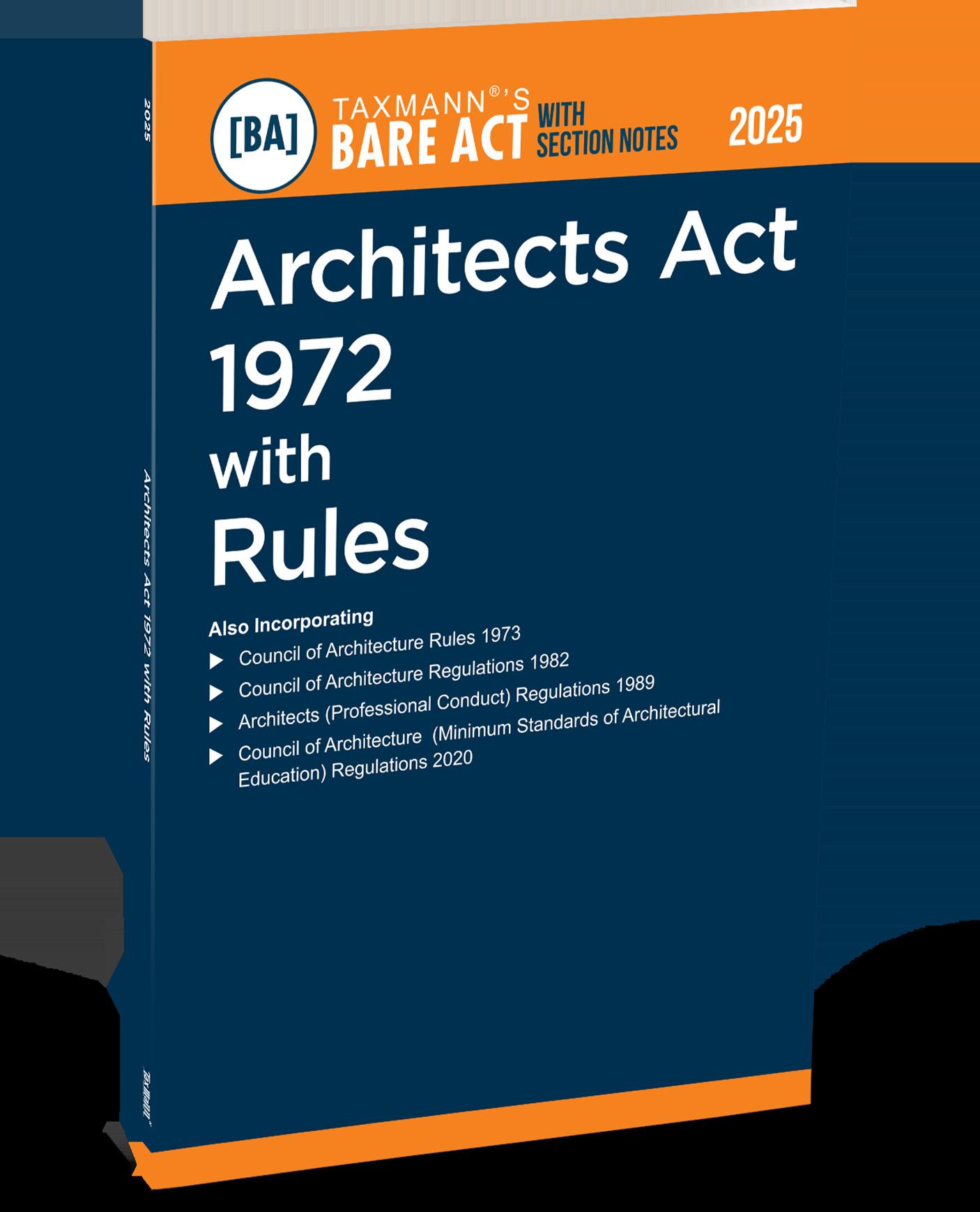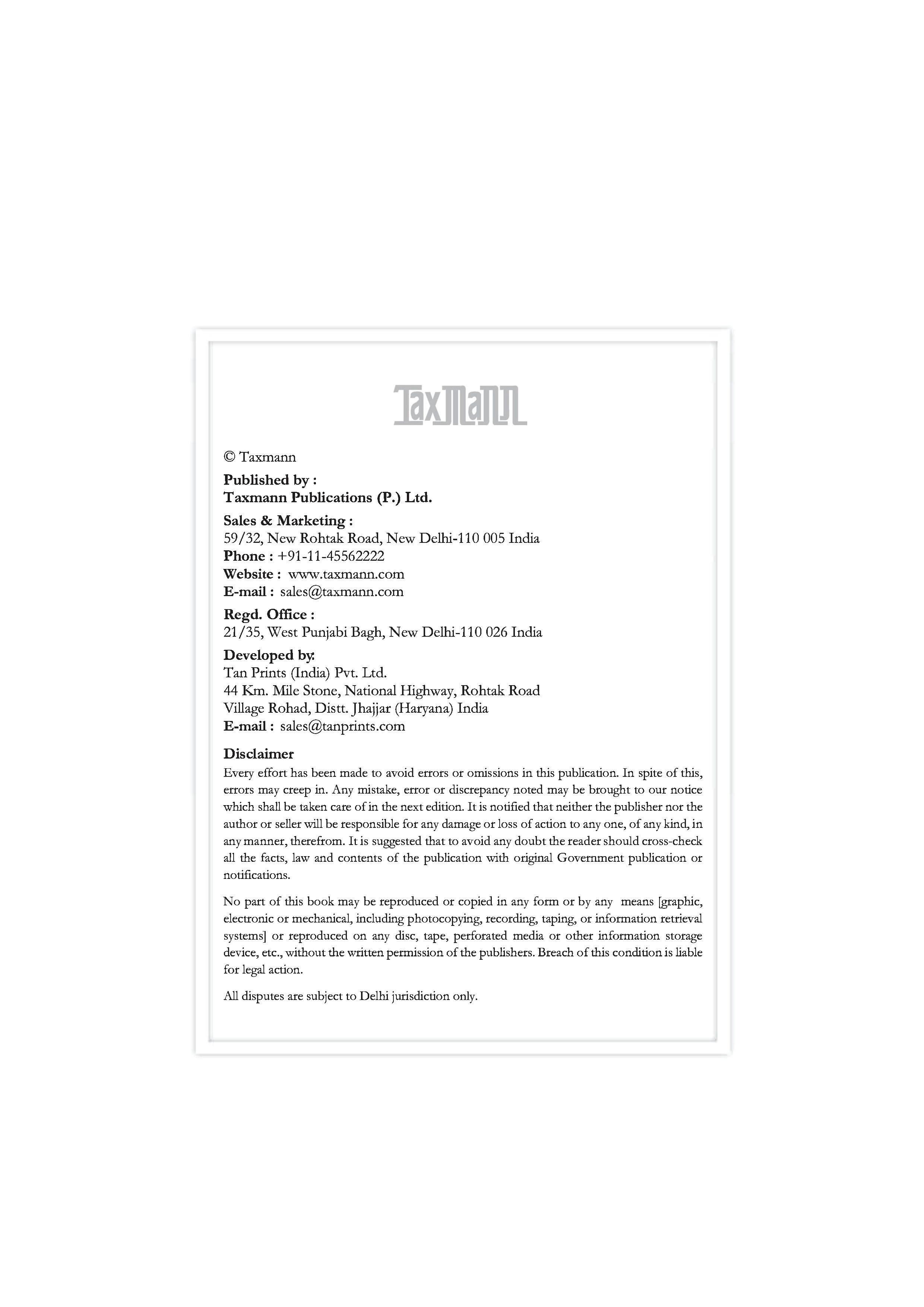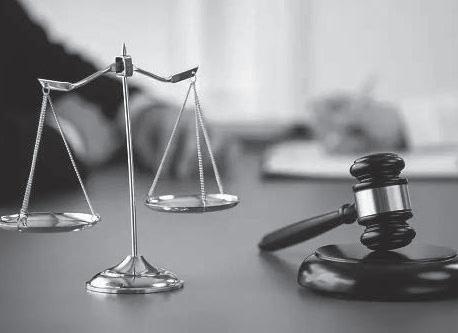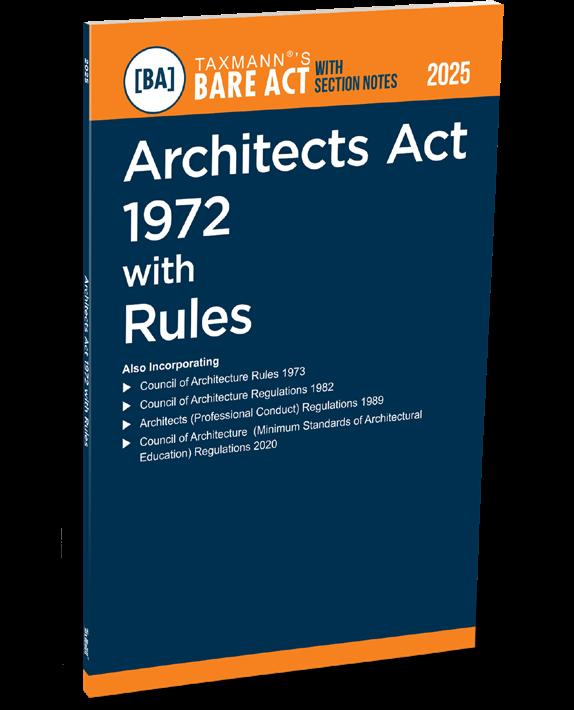
















15. Recognition of architectural qualifications granted by authorities in foreign countries
18.
19. Inspection of examinations
20. Withdrawal of recognition
21.
22.
23.
24.
25.
26.
28.
29. Removal from register
30.
31. Surrender of certificates
32. Restoration to register 16
33. Issue of duplicate certificates 16
34. Printing of register 16
35. Effect of registration 16
36. Penalty for falsely claiming to be registered 16
37. Prohibition against use of title 17
38. Failure to surrender certificate of registration 19
39. Cognizance of offences 20
40. Information to be furnished by Council and publication thereof 20
41. Protection of action taken in good faith
42. Members of Council and officers and employees to be public servants 21
43.
1.
3. Representation of the Indian Institute of Architects
4. Intimation of name of elected person to Central Government
ELECTION TO THE COUNCIL UNDER CLAUSE (c) OF SUB-SECTION (3) OF SECTION 3
5. Filling of the vacancy
5A. Persons entitled to vote and to stand for election
6. Returning Officer
7. Returning Officer to decide questions relating to right of person to vote at or to stand for election
8. Fixation of dates of various stages of election
9. Nomination of Candidates
11. Rejection of nomination paper
12.
13. Withdrawal of
15.
16. Endorsement by Returning Officer on registered cover
17. Candidates may be present when registered covers are opened
18. Rejection of voting papers
CHAPTER IIIA
ELIGIBILITY CRITERIA FOR NOMINATION TO THE MEMBERS OF THE COUNCIL UNDER CLAUSE (F) OF SUB-SECTION (3) OF SECTION 3 OF THE ACT 22A.
CHAPTER IV ELECTION OF PRESIDENT AND VICE-PRESIDENT OF THE COUNCIL UNDER
CHAPTER V ELECTION OF MEMBERS OF THE EXECUTIVE COMMITTEE OF THE COUNCIL UNDER SUB-SECTION (2) OF
7. Notices of meetings of Council 57
8. Business agenda for meetings of Council 58
9. Presiding Officer of meetings of the Council and manner of voting 59
10. Motions to be moved at meetings of the Council 59
11. Amendments to motions at the meetings of Council 60
12. Matters which may be discussed at the time of discussion of a motion 60
13. Adoption of motion 61
14. Adjournment of meetings of the Council 61
15. Commencement of a meeting of Council
16. Points of Order
17. Minutes of the meetings of Council
POWERS AND DUTIES OF PRESIDENT AND VICE-PRESIDENT OF THE COUNCIL
18. Powers and Duties of President 63 19. Powers and Duties of Vice-President 63
20. Conduct of business at the meetings of the Executive Committee 63 21. Functions of the Executive Committee
PART
COMMITTEES OF THE COUNCIL
22. Constitution and conduct of business of committees
REGISTRAR AND EMPLOYEES OF THE COUNCIL
23. Term, powers and duties of Registrar
24. Term, powers and duties of Administrative Officer
25. Terms and conditions of service of the employees
PART VII FINANCE, ACCOUNTS AND AUDIT
26. Finances and Accounts 67
27. Books of Account
28. Audit of Accounts
INSPECTION OF EDUCATIONAL INSTITUTIONS OF ARCHITECTURE
29. Inspection of educational institutions and their examinations 69
30. Powers and duties of Inspectors 70
Architects (Professional Conduct) Regulations, 1989
1. Short title and commencement
2. Definitions
3. Duration of the Architecture Course
4. Admission to the Architecture degree course
5. Intake and Migration
6. Courses and periods of studies
7. Professional examination, Standards of proficiency and conditions of admissions, qualification of examiners
8. Standards of staff, equipment, accommodation, training and other facilities for Architecture education 78
9. Miscellaneous 78
APPENDIX A: Courses, periods of study and subjects of examination under choice based credit system for the architecture degree course
APPENDIX B: Staff requirement
APPENDIX C: Infrastructure requirements
APPENDIX D

An Act to provide for the registration of architects and for matters connected therewith.
BE it enacted by Parliament in the Twenty-third Year of the Republic of India as follows:—
Short title, extent and commencement.
1. (1) This Act may be called the Architects Act, 1972.
(2)It extends to the whole of India.
(3) It shall come into force on such date2 as the Central Government may, by notification in the Official Gazette, appoint.
Definitions.
2. In this Act, unless the context otherwise requires,—
(a)“architect” means a person whose name is for the time being entered in the register;
(b)“Council” means the Council of Architecture constituted under section 3;
(c)“Indian Institute of Architects” means the Indian Institute of Architects registered under the Societies Registration Act, 1860 (21 of 1860);
(d)“recognised qualification” means any qualification in architecture for the time being included in the Schedule or notified under section 15;
(e)“register” means the register of architects maintained under section 23;
(f)“regulation” means a regulation made under this Act by the Council;
(g)“rule” means a rule made under this Act by the Central Government.
1.Dated 31-5-1972.
2. With effect from 1-9-1972.
CASE LAWS
Definition of “Architect” – Applicability to Firms and Juristic Entities - The Delhi High Court interpreted section 2 of the Architects Act, 1972, particularly in relation to the definition and legal identity of an “architect,” holding that the term applies exclusively to individuals who possess a recognized qualification and are registered with the Council of Architecture. The Court emphasized that the Act does not envisage a juristic person such as a company, LLP, or partnership firm to be registered as an “architect,” nor does it allow such entities to hold themselves out as such. However, it clarified that this statutory limitation pertains only to the use of the title “architect,” and not to the rendering of architectural services. Therefore, while firms cannot call themselves “architects,” they may still engage in the business of architectural consultancy if at least one registered architect is involved and there is no misrepresentation. The judgment upheld the legislative intent to protect the sanctity of the professional designation and rejected Council of Architecture circulars that sought to restrict practice by firms, finding them contrary to the statute – Sudhir Vohra v. Union of India AIRONLINE 2018 DEL 51.
Constitution of Council of Architecture.
3. (1) The Central Government shall, by notification in the Official Gazette, constitute, with effect from such date as may be specified in the notification, a Council to be known as the Council of Architecture, which shall be a body corporate, having perpetual succession and a common seal, with power to acquire, hold and dispose of property, both movable and immovable, and to contract, and may by that name sue or be sued.
(2) The Head Office of the Council shall be at Delhi or at such other place as the Central Government may, by notification in the Official Gazette, specify.
(3) The Council shall consist of the following members, namely:—
e) one person nominated by the Central Government; S. 3
(a) five architects possessing recognised qualifications elected by the Indian Institute of Architects from among its members;
(
b) two persons nominated by the All India Council for Technical Education established by the Resolution of the Government of India in the late Ministry of Education No. F.16-10/44-E. III, dated the 30th November, 1945;
(
c) five persons elected from among themselves by heads of architectural institutions in India imparting full-time instruction for recognised qualifications;
(
d) the Chief Architects in the Ministries of the Central Government to which the Government business relating to defence and railways has been allotted and the head of the Architectural Organisation in the Central Public Works Department, ex officio;
(
(f) an architect from each State nominated by the Government of that State;
(g) two persons nominated by the Institution of Engineers (India) from among its members; and
(h) one person nominated by the Institution of Surveyors of India from among its members.
Explanation.— For the purposes of this sub-section,—
(a) “Institution of Engineers (India)” means the Institution of Engineers (India) first registered in 1920 under the Indian Companies Act, 1913 (7 of 1913) and subsequently incorporated by a Royal Charter in 1935;
(b) “Institution of Surveyors of India” means the Institution of Surveyors registered under the Societies Registration Act, 1860 (21 of 1860).
(4) Notwithstanding anything contained in clause (a) of sub-section (3), the Central Government may, pending the preparation of the register, nominate to the first Council, in consultation with the Indian Institute of Architects, persons referred to in the said clause (a) who are qualified for registration under section 25, and the persons so nominated shall hold office for such period as the Central Government may, by notification in the Official Gazette, specify.
(5) Notwithstanding anything contained in clause (f) of sub-section (3), the Central Government may, pending the preparation of the register, nominate to the first Council, in consultation with the State Governments concerned, persons referred to in the said clause (f), who are qualified for registration under section 25, and the persons so nominated shall hold office for such period as the Central Government may, by notification in the Official Gazette, specify.
Election of Council Members – Role of Indian Institute of Architects and No Mandate on Central Government - The Madras High Court clarified that under section 3(3)(a) of the Architects Act, 1972, the election of five architects to the Council of Architecture is to be conducted solely by the Indian Institute of Architects (IIA) from among its members, without any obligation on the part of the Central Government to appoint a Returning Officer. The petitioners had sought a writ of mandamus directing the Central Government to appoint a Returning Officer for this election, alleging abuse and irregularities in the election process. The Court, however, held that while Rule 6 of the Council of Architecture Rules, 1973 mandates a Returning Officer only for elections under section 3(3)(c) (by heads of institutions), there is no such requirement for elections under section 3(3)(a). The responsibility for conducting these elections lies entirely with the IIA, and any grievance related to the election process must be addressed through the statutory remedy provided under section 5(2) of the Act. The Court expressly dissented from a contrary Bombay High Court view and emphasized the legislative intent of segregating responsibilities for different electoral categories –Ar. Vijay Garg v. Ar. P. Satheeshkumar AIR 2009 MADRAS 135.
President and Vice-President of Council.
4. (1) The President and the Vice-President of the Council shall be elected by the members of the Council from among themselves:
Provided that on the first constitution of the Council and until the President is elected, a member of the Council nominated by the Central Government in this behalf shall discharge the functions of the President.
(2) An elected President or Vice-President of the Council shall hold office for a term of three years or till he ceases to be a member of the Council, whichever is earlier, but subject to his being a member of the Council, he shall be eligible for re-election:
Provided that—
(
a) the President or the Vice-President may, by writing under his hand addressed to the Vice-President or the President, as the case may be, resign his office;
(
b) the President or the Vice-President shall, notwithstanding the expiry of his term of three years, continue to hold office until his successor enters upon office.
(3) The President and the Vice-President of the Council shall exercise such powers and discharge such duties as may be prescribed by regulations.
Mode of elections.
5. (1) Elections under this Chapter shall be conducted in such manner as may be prescribed by rules.
(2) Where any dispute arises regarding any such election, the matter shall be referred by the Council to a Tribunal appointed by the Central Government by notification in the Official Gazette in this behalf, and the decision of the Tribunal shall be final:
Provided that no such reference shall be made except on an application made to the Council by an aggrieved party within thirty days from the date of the declaration of the result of the election.
(3) The expenses of the Tribunal shall be borne by the Council.
Terms of office and casual vacancies.
6. (1) Subject to the provisions of this section, an elected or nominated member shall hold office for a term of three years from the date of his election or nomination or until his successor has been duly elected or nominated, whichever is later.
(2) An elected or nominated member may, at any time, resign his membership by writing under his hand addressed to the President, or in his absence, to the VicePresident, and the seat of such member shall thereupon become vacant.
(3) A member shall be deemed to have vacated his seat—
(i) if he is absent without excuse, sufficient in the opinion of the Council, from three consecutive ordinary meetings of the Council; or
(ii) if he ceases to be a member of the body referred to in clause (a), clause (g) or clause (h) of sub-section (3) of section 3 by which he was elected or nominated, as the case may be; or
(iii) in the case where he has been elected under clause (c) of sub-section (3) of section 3, if he ceases to hold his appointment as the head of an institution referred to in the said clause.
(4) A casual vacancy in the Council shall be filled by fresh election or nomination, as the case may be, and the person so elected or nominated to fill the vacancy shall hold office only for the remainder of the term for which the member whose place he takes was elected or nominated.
(5) Members of the Council shall be eligible for re-election or re-nomination, but not exceeding three consecutive terms.
Validity of act or proceeding of Council, Executive Committee or other committees not to be invalidated by reason of vacancy, etc.
7. No act or proceeding of the Council or the Executive Committee or any other committee shall be invalid merely by reason of—
(a) any vacancy in, or defect in the constitution of, the Council, the Executive Committee or any other committee, or
(b) any defect in the election or nomination of a person acting as a member thereof, or
(c) any irregularity in procedure not affecting the merits of the case.
Disabilities.
8. A person shall not be eligible for election or nomination as a member of the Council, if he—
(a) is an undischarged insolvent; or
(b) has been convicted by a court in India for any offence and sentenced to imprisonment for not less than two years, and shall continue to be ineligible for a further period of five years since his release.
Meetings of Council.
9. (1) The Council shall meet at least once in every six months at such time and place and shall observe such rules of procedure in regard to the transaction of business at its meetings as may be prescribed by regulations.
(2) Unless otherwise prescribed by regulations, nine members of the Council shall form a quorum, and all the acts of the Council shall be decided by a majority of the members present and voting.
(3) In the case of an equal division of votes, the President, or in his absence, the Vice-President or, in the absence of both, the member presiding over the meeting, shall have and exercise a second or casting vote.
Executive Committee and other committees.
10. (1) The Council shall constitute from among its members an Executive Committee, and may also constitute other committees for such general or special purposes as the Council deems necessary to carry out its functions under this Act.
(2) The Executive Committee shall consist of the President and the Vice-President of the Council who shall be members ex officio and five other members who shall be elected by the Council from among its members.
(3) The President and the Vice-President of the Council shall be the Chairman and Vice-Chairman respectively of the Executive Committee.
AUTHOR : TAXMANN’S EDITORIAL BOARD
PUBLISHER :
TAXMANN
DATE OF PUBLICATION : JULY 2025
EDITION : 2025 EDITION
ISBN NO : 9789371260787
NO. OF PAGES : 112
BINDING TYPE : PAPERBACK


Architects Act 1972, with Rules [ Bare Act with Section Notes], by Taxmann, is a comprehensive and up-to-date statutory reference for the regulation, recognition, and governance of architects in India. This Edition provides the fully amended text of the Architects Act, along with detailed section-wise notes, case law summaries, and the latest allied rules and regulations on architectural practice, education, and professional conduct. It serves as an essential guide for compliance, registration, and ethical standards in architecture. This book is intended for the following audience:
• Practising Architects and Architectural Firms
• Students & Academicians of Architecture
• Legal Practitioners, Judges & Policy Analysts
• Regulatory Bodies & Government Departments
• Architectural Institutions & Universities
The Present Publication is the 2025 Edition, covering the amended and updated text of the Architects Act [ Act No. 20 of 1972] and Rules, with the following noteworthy features:
• [Comprehensive Coverage] Full, updated text of the Architects Act 1972 with latest amendments
• [Allied Rules & Regulations] Includes Council of Architecture Rules 1973, Regulations 1982, Professional Conduct Regulations 1989, and Minimum Standards of Architectural Education Regulations 2020 (amended up to 2025)
• [Section-wise Notes] Editorial commentary with statutory interpretation and relevant case law
• [Recognised Qualifications] Exhaustive schedule of qualifications in India and abroad
• [Educational Standards] Covers admission, faculty, and infrastructure norms
• [Professional Conduct] Details code of ethics, disciplinary processes, and penalties
• [Procedural Guidance] Forms and formats for registration, complaints, and inquiries
• [Case Law Digest] Summaries of key Supreme Court and High Court judgments
• [Institutional Reference] For regulatory and academic compliance
NOW